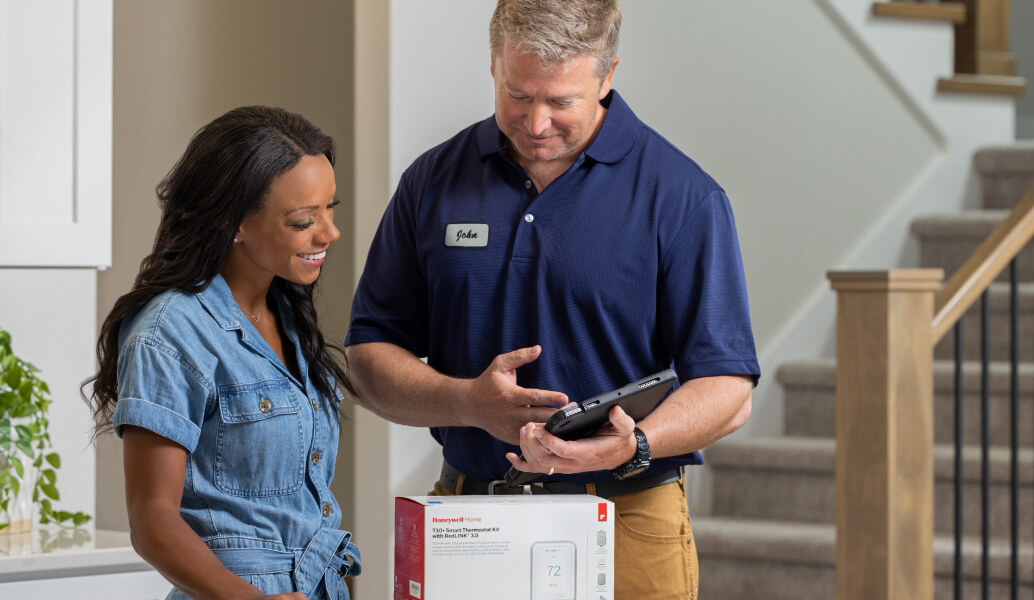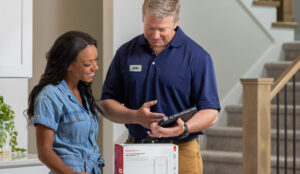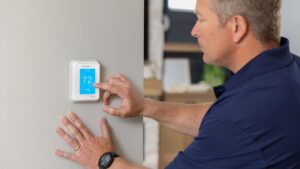Building the Future with Smart HVAC and Plumbing Technologies

By JD Wix
Smart home technology is no longer a luxury, but a standard expectation. As builders continue to adapt to changing consumer demands, increasingly stringent energy regulations and considerations like insurance incentives, the integration of smart HVAC and plumbing systems have emerged as a crucial component of modern homebuilding.
This trend is not just about keeping pace with technology, it’s about future-proofing homes and delivering the energy efficiency, sustainability and convenience that homeowners demand.
Four smart pillars impacting new builds and retrofits
 The integration of smart technology into new builds is shaping the future of the residential market. According to Parks’ Associates Smart Home Dashboard research, 45% of U.S. internet households have at least one smart home device, reflecting a growing demand for intelligent, connected systems. What’s standard in new constructions today often sets the stage for retrofits in existing homes over the next decade. As a result, builders and contractors are tasked with identifying and incorporating the key components of a smart home that will continue to hold value in the years to come.
The integration of smart technology into new builds is shaping the future of the residential market. According to Parks’ Associates Smart Home Dashboard research, 45% of U.S. internet households have at least one smart home device, reflecting a growing demand for intelligent, connected systems. What’s standard in new constructions today often sets the stage for retrofits in existing homes over the next decade. As a result, builders and contractors are tasked with identifying and incorporating the key components of a smart home that will continue to hold value in the years to come.
Contractors are looking for solutions in what I call the four “smart pillars” of new homes: smart thermostats, video doorbells, smart garage openers and smart front door locks. These components are becoming must-haves, reflecting the value that homeowners place on them.
Integrating smart components into new builds meets current market demands and ensures homes are ready for future technological advancements. This foresight is crucial as what is considered cutting-edge today will likely be the norm for retrofits in the next decade.
Impact of smart technology on energy efficiency and sustainability
Energy efficiency and sustainability are at the forefront of both consumer and regulatory demands. As energy costs rise and regulations become more stringent, builders and homeowners, alike seek smart HVAC and plumbing systems to stay compliant and offer enhanced energy performance. In fact, one-third of Gen Z and millennials say energy efficient features are the most important to have in a home. Connected thermostats, for example, are becoming indispensable tools for managing energy consumption.
For single-family homes, a smart thermostat provides homeowners with control over their energy usage, leading to significant savings on utility bills. In multifamily settings, property managers can use smart door locks to remotely manage access and use smart thermostats to manage energy costs across multiple units, especially in vacant apartments, by controlling temperature settings remotely to reduce energy waste and cut down on operational costs.
Moreover, the integration of these smart systems contributes to a home’s overall sustainability. Builders who prioritize energy-efficient solutions in their projects are better positioned to attract eco-conscious buyers and meet the growing demand for green homes. The ability to monitor and control HVAC systems, detect leaks and optimize water usage through smart plumbing solutions and apps are all part of creating a sustainable living environment.
Role of insurance and partnerships in driving adoption
The rising cost of homebuilding, driven by inflation and supply chain challenges, has made cost savings a top priority for homebuilders. One way they are achieving this is by incorporating smart home products that qualify homeowners for insurance discounts. By including products like smart thermostats and leak detectors, contractors can offer added value to buyers. These products enhance the home’s functionality and help mitigate the cost of homeownership by reducing insurance premiums.
This trend is further fueled by partnerships between builders, smart product manufacturers and insurance companies. The 2022 U.S. Home Trends Report from LexisNexis indicates the frequency of preventable home accidents is increasing, jumping nearly 25% from 2015-21, while the cost of preventable losses, including water leaks, nearly doubled during that same period. By partnering with smart product manufacturers and insurance providers, builders can offer homes that are not only technologically advanced, but also specifically designed to reduce risks and deliver substantial financial benefits to buyers.
Smart solutions key to long-term value for multifamily properties
 For owners of multifamily rental buildings, the benefits of smart HVAC and plumbing systems, along with other connected products, extend far beyond daily convenience; they play a critical role in the long-term care and profitability of investment properties. With smart products capable of identifying and preventing leaks, managing HVAC run times and controlling vacant units, while also providing secure, remote access control through smart locks, building owners can safeguard their investments from costly damage, while optimizing energy usage. Smart door access, replacing traditional keys, also saves the time and expense of replacing locks after tenants move out.
For owners of multifamily rental buildings, the benefits of smart HVAC and plumbing systems, along with other connected products, extend far beyond daily convenience; they play a critical role in the long-term care and profitability of investment properties. With smart products capable of identifying and preventing leaks, managing HVAC run times and controlling vacant units, while also providing secure, remote access control through smart locks, building owners can safeguard their investments from costly damage, while optimizing energy usage. Smart door access, replacing traditional keys, also saves the time and expense of replacing locks after tenants move out.
By providing remote monitoring and control, these systems empower owners to maintain efficient operations and reduce energy costs, even when they are not on the premises. The result is not only enhanced tenant satisfaction but also long-term savings and value for multifamily investment properties.
Setting stage for the future with scalable smart solutions
Looking ahead, the trend toward scalable smart solutions is set to shape the next generation of homebuilding. Manufacturers are increasingly designing intro-level smart products that can be easily upgraded to more advanced versions as homeowners’ needs evolve. This flexibility is particularly appealing to both builders and buyers, as it allows for future proofing without significant upfront costs.
For builders, offering scalable solutions is a game-changer. It means they can provide a baseline of connected technology in every home, including smart thermostats, video doorbells, smart garage openers and smart front door locks, with the option for buyers to upgrade later. This approach not only meets current market demands, but also ensures the home remains adaptable to future technological advancements.
As smart HVAC and plumbing systems become standard, the role of builders is evolving. The integration of smart technology is no longer just an option, but a necessity for delivering energy-efficient, sustainable and connected homes that offer long-term value to homeowners. Through ongoing education, strategic partnerships and a focus on scalable solutions, builders can ensure they remain at the forefront of this rapidly evolving industry.
JD Wix is the sales leader for residential new construction, multifamily and property tech at Resideo Pro/Honeywell Home.


